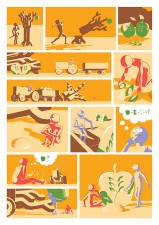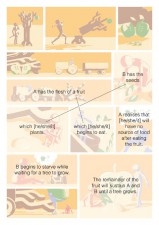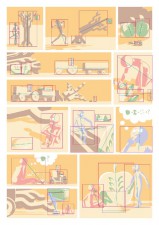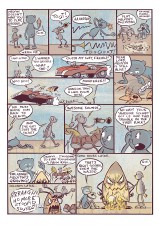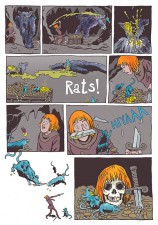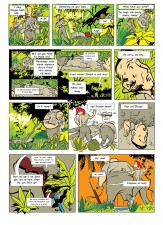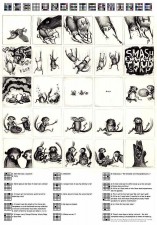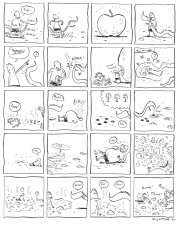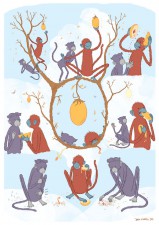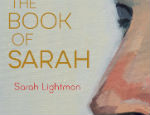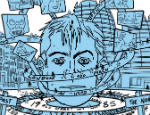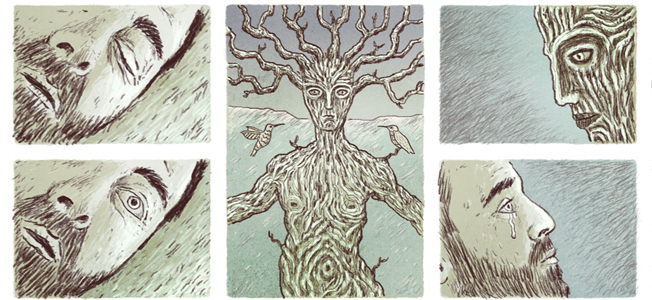 If I were to say that Score and Script is an anthology title quite unlike any other I have reviewed in ‘Small Pressganged’ I would be making a claim that, while strictly accurate in assertion, would also be frighteningly facile in delivery. This multi-creator collaboration was the brainchild of John Miers, evolving from his research project into the mechanics of the comics page that spawned an acclaimed exhibition at the tail end of 2012. Comprising twenty-six one-page strips, Score and Script both analyses and dissects the component parts of the comics form in an attempt to cast new light on the complex relationship between its visual and narrative elements.
If I were to say that Score and Script is an anthology title quite unlike any other I have reviewed in ‘Small Pressganged’ I would be making a claim that, while strictly accurate in assertion, would also be frighteningly facile in delivery. This multi-creator collaboration was the brainchild of John Miers, evolving from his research project into the mechanics of the comics page that spawned an acclaimed exhibition at the tail end of 2012. Comprising twenty-six one-page strips, Score and Script both analyses and dissects the component parts of the comics form in an attempt to cast new light on the complex relationship between its visual and narrative elements.
A confession as prologue: I can do this fascinating project only the scantest justice in the space a short review affords. Fortunately, for the reader who wants more background on this experiment in artistic deconstruction, the handsomely packaged print publication of Score and Script contains not just two dozen-plus comics entries but is also replete with background discussions on the origin of the project, its methodology, and full analysis of the “results”/individual comic strips involved.
Let’s break down the core concept of this experiment then. The entity that all of Score and Script revolves around is Miers’ comic strip on the left above. This was created with the intention of then being split into that titular script (centre) – the narrative template – and the score (right) – the visual template of the active elements of the page – before being distributed (without the underlying original strip’s image of course) to twenty-six of the brightest talents in British comicsdom to interpret as comics of their own.
The outcome was, firstly, ten comics that are based solely on the basic pertinent forms and their placement on the page, adopting the visual structure of the original but, it hardly needs saying, veering away from Miers’ original narrative parable (which in itself acts as a metaphor for the whole exercise). Compare the three examples below to see how Jaime Huxtable’s wonderfully bizarre entry, John Riordan’s tale of ill-fated dungeon marauding and Stuart Medley’s account of intelligent would-be world-conquering insects replicate the layout of the score template. To border on the oxymoronic for the moment, all of these shorts visually echo their progenitor but all head off on their own unique storytelling tangents, whether it’s Woodrow Phoenix giving us the all-ages fun of a mole with a love for the milliner’s art or Sean Azzopardi’s tragic slice-of-lifer.
Left to right – Jaime Huxtable, John Riordan and Stuart Medley’s contributions to the “Score” side of the project
The second half of the anthology presents fifteen comics that work from the stripped down script, providing us with a fascinating array of vastly different stylistic interpretations and visual approaches to the core narrative idea. In the examples reproduced below you can note that although the same basic tale is being told by Tanya Meditzsky, Gary Northfield and David O’Connell, their approaches to the script template have taken them all down very different visual paths – sometimes quite radically so.
It’s not just the formation of the strips that can vary wildly here. Tone fluctuates significantly across the offerings. Northfield (The Phoenix and Teenytinysaurs) uses a very traditional layout for one of those gloriously silly romps he excels at (below centre), for example, while Tim Hassan’s beautiful but static imagery offers design-led philosophical contemplation; that same diversity again underlining the boundless possibilities of the comics page.
In the circumstances it seems somehow fitting that to conclude a review of Score and Script I also need to distil it into its two central parts: a piece of academic research and a showcase of indie comics talent. In the first instance what Miers has curated here is astonishingly effective, educating the readers by inviting them to be participants in the exercise, to make discoveries for themselves about the relationship between content and presentation as they flick backwards and forwards through Score and Script’s pages.
Left to right – Tanya Meditsky, Gary Northfield and David O’Connell’s contributions to the “Script” side of the project
However, those wishing to completely disregard the scholarly nature of John’s investigation of the building blocks of sequential art and how they interact can, of course, come to this simply as another splendid Brit anthology full of old fave creators and new faces to investigate further. You would be missing out on something rather special if you did so but the book absolutely works on that more superficial level as well. With the likes of AJ Poyiadgi (see sample top image), Richy K. Chandler, Daniel Merlin Goodbrey, Sally-Anne Hickman, John Cei Douglas, Steven Walsh, Mike Medaglia, Dan Berry, Elliot Baggott and Douglas Noble and many others also within its interiors it’s hardly lacking in UK small press talent after all.
Score and Script is not just a comics anthology but also a celebration of the sprawling potential of the form. An insightful study of the technicalities of the medium that manages to both inform and entertain. Those of us who have been exposed to the work of John Miers already are fully aware of his intuitive grasp of the mechanics of the comics page. If you’re being introduced to his name for the first time through this column – and that is, after all, a large part of the remit of ‘Small Pressganged’ – then I would urge you to follow the links to his site and online store below and make Score and Script the very first thing you order…
For more on the work of John Miers then check out his site here. A PDF of his paper on Script and Score presented in 2013 at Central Saint Martins, part of the University of the Arts London, is available here. His online store is here where you can buy print copies of Score and Script priced £6.00.





